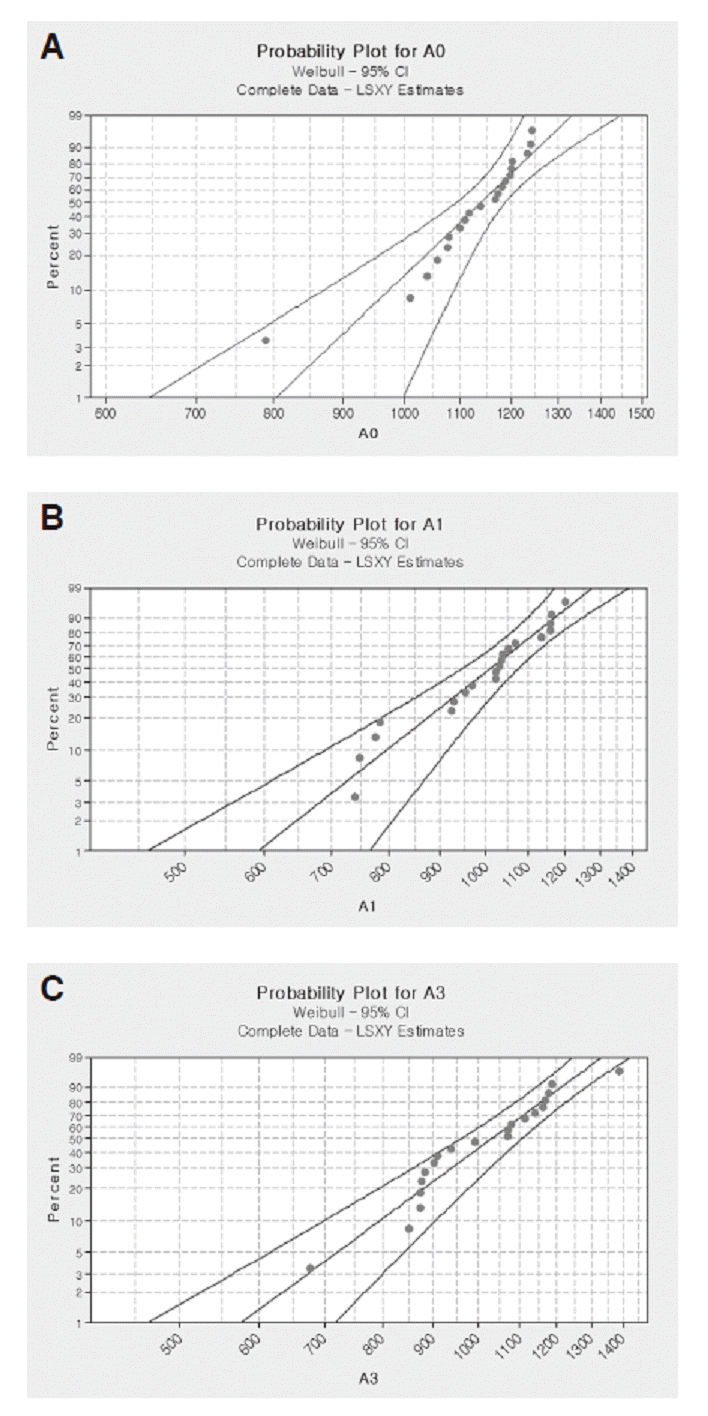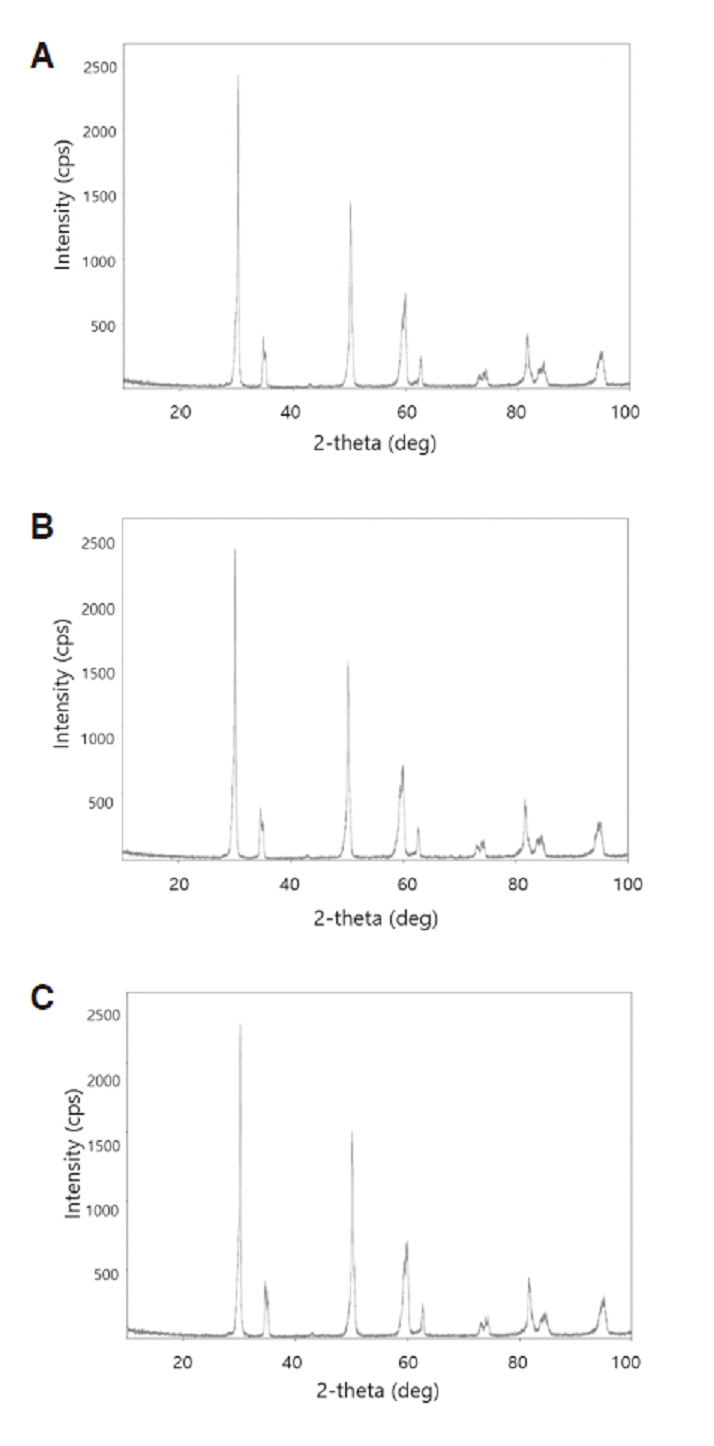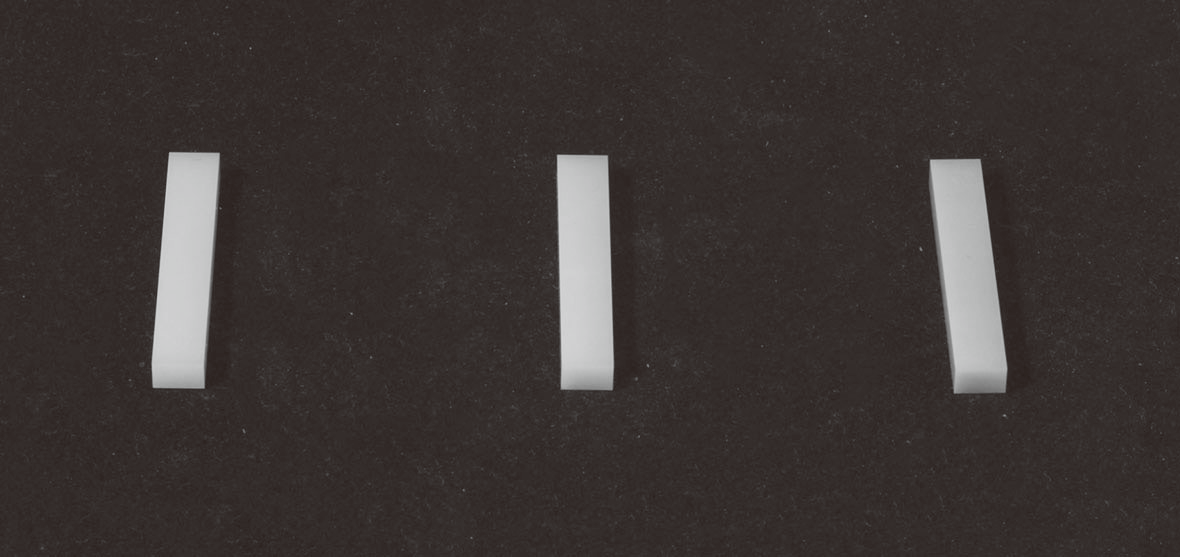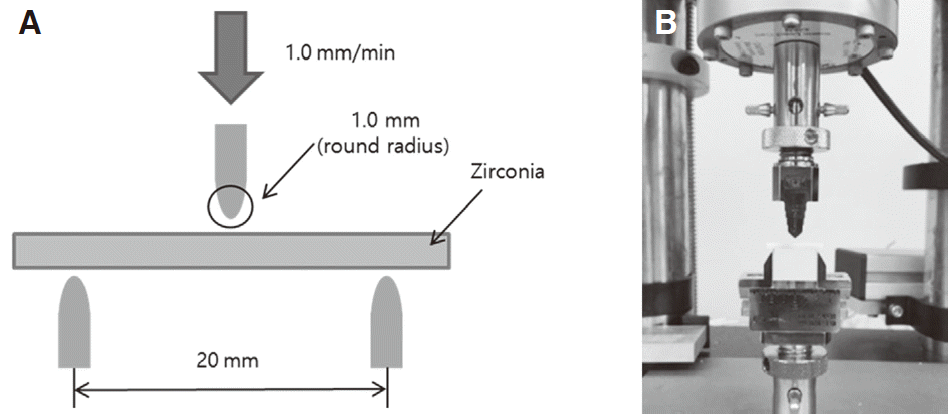Abstract
Purpose
The purpose of this study was to evaluate the flexural strength and reliability of highly translucent colored zirconia for all ceramic restoration.
Materials and Methods
Bar-shaped specimens (25 × 4 × 2.5 mm) were prepared from highly translucent monolithic zirconia. Three experimental groups were set up according to color (shade A0, A1, and A3). For each group, 20 specimens were prepared. Flexural strength was determined using a 3-point flexural test and results were analyzed with one-way ANOVA test. Weibull statistical analysis provided 2 parameter estimates: Weibull modulus and characteristic strength. X-ray diffraction (XRD) analysis was performed.
Results
There was statistically significant difference between uncolored (Shade A0) and colored (shade A1 and A3) (P < 0.05), but there was no difference between colored groups (P > 0.05). The uncolored group had higher reliability compared with colored study groups. On x-ray diffraction analysis of each group, typical peaks of tetragonal phase appeared in all groups.
Conclusion
Within the limitations of this in vitro study, coloring highly translucent zirconia had significant effect on flexural strength and reliability. Therefore, clinicians should be careful when using highly translucent colored zirconia to prevent breakage of veneering ceramic and enhance aesthetics.
초록
연구 재료 및 방법
전부도재 수복물을 위해 사용되는 무색(A0) 및 유색(A1, A3)의 고반투명 지르코니아 블록을 사용하여 바 형태의 시편(25 × 4 × 2.5 mm)을 제작하였다. 지르코니아 블록의 색조에 따라 3개의 실험군을 설정하였고, 한 군당 20개의 시편을 제작하였다. 굽힘강도는 3점 굽힘시험을 통해 측정하였으며, 일원배치 분산분석을 이용하여 색조에 따른 통계적 유의성을 검증하였다. 다음으로 세라믹 재료 특성상 신뢰도를 평가하기 위해 와이블 분석을 시행하였으며, X선 회절분석으로 시편의 결정특성을 분석하였다.
Fixed restorations based on 3 mol % yttrium oxide stabilized tetragonal zirconia polycrystals (3Y-TZP) have become popular because its transformation toughening ability helps prevent crack propagation by increasing localized fracture resistance.
1
Notwithstanding the superior mechanical properties, the white color of zirconia restrict its use in highly esthetic areas. And that’s why zirconia restorations were first introduced in prosthetic dentistry as a core material and then layered by feldspathic porcelain. However, veneer chipping has been reported as frequent complication. The natural white color of zirconia with the veneer chipping problem has led to the development of tooth colored monolithic zirconia.
2
Recently, highly translucent monolithic zirconia with various shades has been introduced to eliminate the risk of chipping and achieve more natural looking properties.
3
However, using coloring metal oxide to obtain shade in 3Y-TZP has the potential to lead to crystallographic and microstructure changes that could in turn affect the mechanical properties of 3Y-TZP.
4
Previous studies have reported that there was significant difference in flexural strength between colored and uncolored zirconia.
5,6
Fracture toughness and strength was considerably sacrificed in highly translucent zirconia.
7
The processes that enhance translucency, and the added coloring elements, have been shown to affect the mechanical properties of the material. Strategies for improving the optical performance of 3Y-TZP include increasing yttria content, microstructure variation, reducing the alumina dominant and creating a nanometric microstructure.
8
Even small changes in these factors can cause significant differences in the microstructural and physical properties. Nevertheless, few studies investigated the influence of shade on the physical properties of highly translucent monolithic zirconia.
Therefore, the aim of this study was to evaluate and compare flexural strength and reliability of highly translucent colored zirconia. The null hypothesis was that there is no difference in flexural strength between colored and uncolored highly translucent zirconia.
A total of 60 bar-shaped specimens (25 × 4 × 2.5 mm) were milled from presintered 3Y-TZP highly translucent zirconia blocks (Razor, UNC Int., Seoul, Korea) (Fig. 1) and three experimental groups were set up according to shade. Uncolored (A0) and colored (A1 and A3) blocks were used in this study. The specimens were prepared using an electrical high precision saw (IsoMet 1000 Precision Saw, Buehler Ltd, Lake Bluff, USA) under wet conditions and washed in tap water to remove the cutting debris. After that, specimens were finished manually with a ceramic polisher (Diapol, Eve Ernst Vetter GmbH, Keltem, Germany) with a low-speed handpiece under constant water irrigation. The dimensions of the specimens were measured with a digital caliper (SD500-200PRO, Sincon Corp., Seoul, Korea).
Specimens were loaded until fracture occurred in a universal testing machine (Instron 5848, Instron Corp., Canton, USA) according to ISO 6872 and previous studies.
9-11
The load was vertically applied with a steel knife edge rounded to a radius of 1.0 mm, centered on the specimen, at a crosshead speed of 1.0 mm/min (Fig. 2).
The variability of the flexural strength data was analyzed using a 2-parameter Weibull cumulative distribution function.
12-14
The following equation was used to calculate the Weibull monulus:
Pf(σ) = 1 - exp [-(σ/σ0)m],
where Pf(σ) is the probability of failure, σ is the fracture strength, σ0 is the characteristic parameter corresponding to the fracture probability of 63.2%, and m is the Weibull modulus. Weibull distribution graphs were obtained with software (Minitab ver18.0, Minitab LCC., USA).
XRD patterns were carried out by using a diffractometer (Miniflex, Rigaku Corp., USA) within the 2θ range of 10 to 100 degrees, covering the positions of the highest peaks of tetragonal and monoclinic phases of ZrO2. Cukα radiation was generated at 40 kV and 40 mA. Mass fraction of the monoclinic phase (Xm) was calculated with the method suggested by Garvie and Nicholson
15
:
Xm = (Im[-111] + Im[111] / [Im[-111] + Im[111] + It[101]]),
where Xm is the mass fraction of the monoclinic phase, Im(-111) is the intensity of the monoclinic peak at 28.2 degrees, Im(111) is the intensity of the monoclinic peak at 31.5 degrees, and It(101) is the intensity of the tetragonal peak at 30.2 degrees.
The volume fraction of the monoclinic phase (Vm) was calculated with the method suggested by Toraya el al16:
Vm = 1.311Xm / (1 + 0.311Xm),
where Vm is the volume fraction of the monoclinic phase and Xm is the mass fraction of the monoclinic phase.
Statistical analysis was performed with software (SPSS 23.0, IBM Inc., Armonk, USA). The normality of distributions was explored by Kolmogorov-Smirnov test, and the groups were distributed normally. Flexural strength of uncolored and colored groups was evaluated with one-way ANOVA followed by the Tukey’s honestly significant difference (HSD) post hoc test. Statistical significance was set atP < 0.05.
The mean of flexural strength of the three groups are presented inTable 1. The shade A0 group showed the highest mean flexural strength compared with those of A1 and A3, and the differences were of statistical significance (P < 0.05). No significant difference was found between A1 and A3 (P > 0.05) (Table 2).
The Weibull analysis was performed to evaluate the reliability of each group (Fig. 3). A higher Weibull modulus signifies higher reliability for specimen strength. The shade A0 (12.09) study group had higher reliability compared with A1 (7.97) and A3 (7.31) study groups.
On x-ray diffraction analysis of each group, typical peaks of tetragonal phase appeared in all groups (Fig. 4). Volume fraction (Vm) of the monoclinic phase was 2.9% for the A0 group, 3.2% for A1, and 4.6% for the A3 group.
The present study evaluated the flexural strength and reliability of highly translucent colored zirconia. According to the results of the study, the null hypothesis that there is no difference in flexural strength between uncolored and colored zirconia was rejected.
Recently, the use of zirconia prosthesis with computer-aided design/computer-aided manufacturing (CAD/CAM) method has been increasing. Among dental ceramics, 3Y-TZP possesses excellent mechanical properties such as highest fracture resistance and fracture toughness, which contributes to its wide use in prosthodontic treatment that ranges from a single tooth restoration to full mouth rehabilitation.
17
Moreover, it shows a more than 90% success rate in over 10-year long-term clinical studies.
18,19
Factors affecting the translucency of zirconia include thickness, porosity, the density of specimen, size of the crystal, etc. It was reported that a small quantity of Al
2
O3 included in zirconia reduces the translucency due to the effect of light scattering.
20
Highly translucent zirconia with more than 40% translucency used in this study did not contain Al
2
O3, and it was comparable to typical highly translucent zirconia (Lava Plus High Translucency Zirconia, 3M ESPE, Seefeld, Germany) with more than 30% translucency.
On the flexural strength analysis using highly translucent monolithic zirconia in this study, the result of uncolored zirconia (1127.10 MPa) was significantly higher than shade A1 (995.71 MPa) and shade A3 (1016.42 MPa). Meanwhile, there was no statistically significant difference between A1 and A3. Considering that, the flexural strength of highly translucent monolithic zirconia in this experiment may be affected by coloring oxide, yet, the result of colored groups was acceptable for clinical use.21 Therefore, colored highly translucent monolithic zirconia may be used stably in a visible area requiring a high level of aesthetics.
Generally, previous studies suggested that the Weibull modulus of 5 to 15 is appropriate for dental ceramic.22 The Weibull modulus of the specimen used in this study is between 7.31 (shade A3) and 12.09 (shade A0). These results imply that the uncolored zirconia breaks steadily and has high reliability.
Based on the results of X-ray diffraction, we concluded that the addition of coloring oxides during fabrication of highly translucent zirconia does not affect the formation of tetragonal crystal phase. The result was consistent with previous studies.
23,24
The acceptable level of volume fraction of the monoclinic phase in dental zirconia is below 25%.
25
A lot of transformations into the monoclinic phase reduces mechanical stability by time and may affect crack-stopping or crack-retarding properties of zirconia. The volume fraction of the monoclinic phase in zirconia used in this study was 2.9%, 3.2% and 4.6% for shade A0, A1, and A3 respectively, all were within the acceptable level.
The present study measured the flexural strength and reliability of the bar-shaped specimen when a load is directed perpendicular to the long axis of the specimen. However, there is a limitation in applying the study result in clinical practice as the intraoral condition differs from the experimental environment. Therefore, future studies will need to focus on a highly translucent colored zirconia fabricated in crowns suitable for anterior, premolar, and molar region.
Within the limitation of the current study, the flexural strength of highly translucent monolithic zirconia was statistically significantly high in uncolored group compared with colored, but there was no significant difference between colored groups. Also, the uncolored group had higher reliability than colored study groups. Therefore, clinicians should be careful when using highly translucent colored zirconia to prevent breakage of veneering ceramic and enhance aesthetics.
REFERENCES
1. Johansson C, Kmet G, Rivera J, Larsson C, Vult Von Steyern P. 2014; Fracture strength of monolithic all-ceramic crowns made of high translucent yttrium oxide-stabilized zirconium dioxide compared to porcelain-veneered crowns and lithium disilicate crowns. Acta Odontol Scand. 72:145–53. DOI: 10.3109/00016357.2013.822098. PMID: 23865549.
2. Kim HK, Kim SH. 2014; Effect of the number of coloring liquid applications on the optical properties of monolithic zirconia. Dent Mater. 30:229–37. DOI: 10.1016/j.dental.2014.04.008. PMID: 24853434.
3. Inokoshi M, Shimizu H, Nozaki K, Takagaki T, Yoshihara K, Nagaoka N, Zhang F, Vleugels J, Van Meerbeek B, Minakuchi S. 2018; Crystallographic and morphological analysis of sandblasted highly translucent dental zirconia. Dent Mater. 34:508–18. DOI: 10.1016/j.dental.2017.12.008. PMID: 29325861.
4. Kaya G. 2013; Production and characterization of self-colored dental zirconia blocks. Ceram Int. 39:511–7. DOI: 10.1016/j.ceramint.2012.06.056.
5. Oh SC, Lee HH, Shin MR, Lee IK. 2007; Flexural strength of various colored and uncolored zirconia ceramics for all-ceramic restoration. J Dent Rehabil Appl Sci. 23:119–30.
6. Hjerppe J, Närhi T, Fröberg K, Vallittu PK, Lassila LV. 2008; Effect of shading the zirconia framework on biaxial strength and surface microhardness. Acta Odontol Scand. 66:262–7. DOI: 10.1080/00016350802247123. PMID: 18645687.
7. Zhang F, Inokoshi M, Batuk M, Hadermann J, Naert I, Meerbeek BV, Vleugels J. 2016; Strength, toughness and aging stability of highly-translucent Y-TZP ceramics for dental restorations. Dent Mater. 32:e327–37. DOI: 10.1016/j.dental.2016.09.025. PMID: 27697332.
8. Zhang Y. 2014; Making yttria-stabilized tetragonal zirconia translucent. Dent Mater. 30:1195–203. DOI: 10.1016/j.dental.2014.08.375. PMID: 25193781. PMCID: PMC4167579.
9. International Organization for Standardization. ISO 6872:2008. Dentistry - Ceramic materials. Available from: https://www.iso.org/standard/41385.html (updated 2020 Mar 10).
10. Siarampi E, Kontonasaki E, Papadopoulou L, Kantiranis N, Zorba T, Paraskevopoulos KM, Koidis P. 2012; Flexural strength and the probability of failure of cold isostatic pressed zirconia core ceramics. J Prosthet Dent. 108:84–95. DOI: 10.1016/S0022-3913(12)60112-7. PMID: 22867805.
11. Garcia Fonseca R, de Oliveira Abi-Rached F, dos Santos Nunes Reis JM, Rambaldi E, Baldissara P. 2013; Effect of particle size on the flexural strength and phase transformation of an airborne-particle abraded yttria-stabilized tetragonal zirconia polycrystal ceramic. J Prosthet Dent. 110:510–4. DOI: 10.1016/j.prosdent.2013.07.007. PMID: 24182897.
12. Weibull W. 1951; A statistical distribution function of wide applicability. J Appl Mech. 18:293–7.
13. Ritter JE. 1995; Predicting lifetimes of materials and material structures. Dent Mater. 11:142–6. DOI: 10.1016/0109-5641(95)80050-6. PMID: 8621036.
14. Kittl P, Diaz G. 1988; Weibull's fracture statistics or probabilistic strength of materials: state of the art. Res Mechanica. 24:99–207.
15. Garvie RC, Nicholson PS. 1972; Phase analysis in zirconia systems. J Am Ceram Soc. 55:303–5. DOI: 10.1111/j.1151-2916.1972.tb11290.x.
16. Toraya H, Yoshimura M, Somiya S. 1984; Calibration curve for quantitative analysis of the monoclinic-tetragonal ZrO2 system by x-ray diffraction. J Am Ceram Soc. 67:119–21. DOI: 10.1111/j.1151-2916.1984.tb19715.x.
17. Guess PC, Schultheis S, Bonfante EA, Coelho PG, Ferencz JL, Silva NR. 2011; All-ceramic systems: laboratory and clinical performance. Dent Clin North Am. 55:333–52. DOI: 10.1016/j.cden.2011.01.005. PMID: 21473997.
18. Håff A, Löf H, Gunne J, Sjögren G. 2015; A retrospective evaluation of zirconia-fixed partial dentures in general practices: an up to 13-year study. Dent Mater. 31:162–70. DOI: 10.1016/j.dental.2014.11.009. PMID: 25529500.
19. Stefanescu C, Ionita C, Nechita V, Drafta S, Oancea L, Petre A. 2018; Survival rates and complications for zirconia-based fixed dental prostheses in a period up to 10 years: a systematic review. Eur J Prosthodont Restor Dent. 26:54–61. DOI: 10.1922/EJPRD_01681Stefanescu08. PMID: 29517875.
20. Tong H, Tanaka CB, Kaizer MR, Zhang Y. 2016; Characterization of three commercial Y-TZP ceramics produced for their high-translucency, high-strength and high surface area. Ceram Int. 42:1077–85. DOI: 10.1016/j.ceramint.2015.09.033. PMID: 26664123. PMCID: PMC4671392.
21. Ferrario VF, Sforza C, Zanotti G, Tartaglia GM. 2004; Maximal bite forces in healthy young adults as predicted by surface electromyography. J Dent. 32:451–7. DOI: 10.1016/j.jdent.2004.02.009. PMID: 15240063.
22. Guazzato M, Quach L, Albakry M, Swain MV. 2005; Influence of surface and heat treatments on the flexural strength of Y-TZP dental ceramic. J Dent. 33:9–18. DOI: 10.1016/j.jdent.2004.07.001. PMID: 15652163.
23. Spyropoulou PE, Kamposiora P, Eliades G, Papavasiliou G, Razzoog ME, Thompson JY, Smith RL, Bayne SC. 2016; Composition, phase analysis, biaxial flexural strength, and fatigue of unshaded versus shaded Procera zirconia ceramic. J Prosthet Dent. 116:269–76. DOI: 10.1016/j.prosdent.2015.08.030. PMID: 27016181.
24. Wen N, Yi YF, Zhang WW, Deng B, Shao LQ, Dong LM, Tian JM. 2010; The color of Fe2O3 and Bi2O3 pigmented dental zirconia ceramic. Key Engineering Materials. 434:582–5. DOI: 10.4028/www.scientific.net/KEM.434-435.582.
25. Ozer F, Naden A, Turp V, Mante F, Sen D, Blatz MB. 2018; Effect of thickness and surface modifications on flexural strength of monolithic zirconia. J Prosthet Dent. 119:987–93. DOI: 10.1016/j.prosdent.2017.08.007. PMID: 29042115.
Fig. 3
Weibull distributions. Curved lines 95% confidence limits. (A) Shade A0, (B) Shade A1, (C) Shade A3.

Fig. 4
X-ray diffraction peaks of zirconia specimen surface. (A) Shade A0, (B) Shade A1, (C) Shade A3.

Table 1
Mean flexural strength (in MPa) for the A0, A1, A3 groups
| Group | N | Mean | SD | 95% CI | Max | Min | |
|---|---|---|---|---|---|---|---|
| Lower Upper | |||||||
| A0 | 20 | 1127.10 | 105.58 | 1064.18 | 1190.02 | 1243.36 | 788.61 |
| A1 | 20 | 995.71 | 143.25 | 932.79 | 1058.62 | 1199.93 | 740.69 |
| A3 | 20 | 1016.41 | 166.03 | 953.50 | 1079.34 | 1385.93 | 675.85 |




 PDF
PDF Citation
Citation Print
Print





 XML Download
XML Download